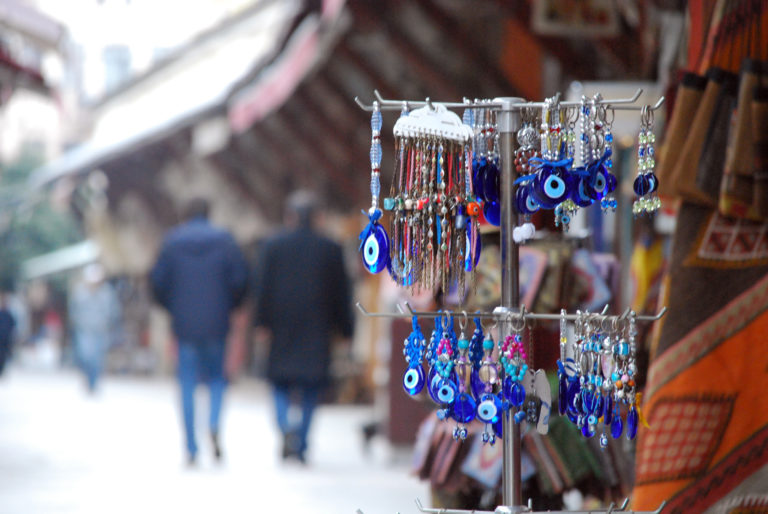
Image by Spiros K./Flickr, Attribution-NonCommercial-NoDerivs.
Nazar: Energies Exchanged in a Glance
If you travel around the Middle East, Iran, Central Asia, and South Asia, you’ll see a ubiquitous series of necklaces, charms, bracelets, tiles, and decorations that are variously known as the “evil eye.”
They are everywhere. People hang them on their babies, on their own jewelry, inside their homes, off the rear-view mirrors in their cars. They call it nazar.
I remember one of the first times I took my beautiful baby girl, Roya, to Turkey. Turkish grandmothers who did not speak a word of English would come up to me and talk to me rapidly, looking and not looking at my baby girl who looked like a baby doll. I didn’t speak much Turkish then, and I wasn’t quite sure if I was being blessed or cursed. It turns out that it was a bit of both. It was a blessing upon my beautiful, too beautiful, baby girl… and a bit of a curse on me for not having been protective enough to put enough amulets, talismans, and charms on her and around her. Invariably, the grandmothers would reach into their pockets and bring out an “evil eye” amulet, attach it to a gold safety pin, and pin it somewhere on my baby’s clothing.
In America, if a stranger comes up to you and speaks to you and affixes a charm onto your child, well, you might be alarmed. In Turkey, and in much of the Middle East, it’s just Thursday. It is an everyday occurrence. So it got me to wonder: What was really going on?
I asked my Turkish friends about it. Some of them would giggle in an embarrassed way and dismiss it as the superstition of the grandmothers. Others talked about an ancient mentality of a bygone era, before we became “modern” and “scientific.” But I knew that in rich and ancient cultures like this, no practice becomes this ubiquitous unless it is tied to some ancient, wise teaching.
I kept asking, and the answer turned out to be much more fascinating, and relevant to our own lives here and now, than one would have thought. The idea is that when we look at one another, we are not so much seeing one another as we are exchanging energies. It is true: eyes are the windows to the soul. Glances are not neutral, but always an exchange of desires, positive energy, and negative energy.
Therein lies the mystery of the Turkish nazar. The amulet is not really an “evil eye” — it is more of an evil eye repellent. The blue circle in the middle of the amulet is intended to serve as a false eye, a deception, a ruse. If a person casts a negative glance at another, the amulet receives the negative energy of that “evil eye” so that it cannot enter the soul of the innocent party through their real eyes.

Looking into the depth of the mystical tradition of Islam, I came to learn that nazar did not actually mean “evil eye.” Or at least it does not always mean “evil eye.” It simply means “glance.” Love poetry from the Islamic tradition is filled with a discussion of nazar, glances. Love glances. The glances are often compared to an arrow that is shot through the bow of a Beloved’s perfectly arched eyebrow, finding its target in the open and vulnerable heart of a lover.
I learned about Muslim lovers of the Prophet who pray again and again to be given one glance, one nazar (in other languages, one negah) of the Blessed Prophet (S). Here’s one of the loveliest devotional songs for the Prophet, the lovely Qawwali song “Tajdar-e Haram”:
Tajdar-e Haram,
Ho Negah-e Karam
ham ghareebon ke din
Bhi sanwar jaaen ge
“O King of the Sanctuary (the Prophet)
Bless us with one merciful glance
So that our days of Woe
May turn for the better”
The lover prays for one simple glance from the Prophet. She might even list all of her ailments, shortcomings, and sins. So why does she beg the Prophet (S) for a glance? Because if the Prophet were to look at her, the healing power of his glance would mean that her condition would no longer be miserable, but joyous. Such is the power of a healing glance from a lover. Oh, to be looked at through such a glance…
In another Muslim text, the Dala’il al-Khayrat, the glance is reversed. This time the focus is not so much on the glance of the Prophet, but rather the glance of the lovers on the Prophet. This is a text that many Muslim lovers of God and the Prophet recite on a nightly basis:
My God!
I have faith in our master Muhammad,
Though I was never blessed to see him.So in the Hereafter,
Do not deprive me
of a vision of him.
There is a beauty in glances, in casting love glances, and in being seen for who we truly are. Glances, like kisses and embraces, are given and received.
So what if the glance is not merely an evil eye, but an awareness of the grace, the exchange of energies that happens each time we cast a glance upon one another?
These days I am more mindful than ever of the ways that, in our crowded public arena, we are constantly exchanging energies. Words, glances, online comments…
Tempers flare.
Unwanted sexual advances abound.
Rageaholics everywhere.
Ours is an age of snark. Even presidential candidates sometimes seem to be the comments section come to life.
I wonder, do we have those in our midst whose very being can serve as an “evil eye repellent”? Who is willing to stand in the midst of all the snark, and absorb the snark without retaliating, and without causing harm to their own hearts?
Are we willing to cast upon each other glances that are filled with mercy?
Are we willing to look at each other with love glances that are welcomed?
Are we willing to receive such loving and kind glances?
The Turkish grandmothers, and the wisdom of the ancients, are all right. There is a magic that dwells in our exchange of glances.
May we purify our hearts so that the glances we cast upon one another are healing glances, loving glances. May we create communities and relationships worthy of these love glances.

